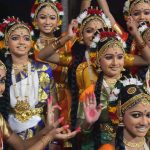Kathakali Dance – India (30.04.17)
One of the highlights of my recent trip to Cochin was meeting and interviewing the celebrated artists that perform the centuries-old Kathakali Hindu dance – the most famous performing art of Kerala.

It was a humbling and extraordinary experience to be afforded the luxury of ‘access to all areas’. Hearing first-hand how dedicated the performers and musicians have to be to execute such an historic martial art performance.
I interviewed Mohan, one of Cochin’s leading professional Kathakali dancers, before he began his two hour pre-performance make-up session. I watched as he explained the significance of intricate face painting, and stayed backstage as the actors and musicians readied themselves for their evening show at the Greenix Village Cultural Centre in Fort Cochin.

Mohan explained how, living in a village famous for Kathakali performers, he became a professional artist after studying the traditions, dance routines, hand gestures and eye movements for ten years. After this, he could perform the parts, to the specific traditional music and song, of all the characters in over sixty stories.
This is no mean feat when the focus remains on completing these classical Malayalam-speaking dance enactments in strict accordance with 700 year old traditional Hindu principles, mythologies and beliefs.

As with historical performing arts in many other parts of the globe, the Sanskritised Malayalam characters are traditionally played by men. They were originally performed in theatres (Kuttampalam), courts and temples across southern India. To this day, the elaborate, colourful costumes – enhanced with painstakingly precise facial make-up – are as much a part of the performance as the enormous and varied array of Kathakali dramas.
Before Bollywood, Kathakali dancing was Kerala’s most revered of the performing arts. Today this rich and beautiful art form, encompassing over five hundred different plays, is still renowned as one of the most important traditional cultural enactments.

Morhan said that when he performs he becomes totally swept up in the story. ‘I become the character I am playing, leaving behind whatever everyday stresses and strains I have’. Which must be fun, given that he often acts the part of one of the demi-gods or heroes (more often than not Krishna or Rama), known for their serenity, good-humour and heroism.

While observing the long and complicated costume and make-up rituals backstage, I also noticed that the whole routine, involving up to three or four helpers, is conducted in near silence with the help of sign language. It is similar to the stage performance itself in which the characters’ conversation and responses are mimed through eye movements and hand signals (mudras).
























